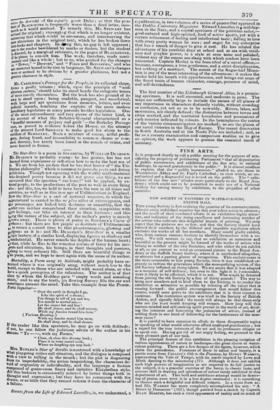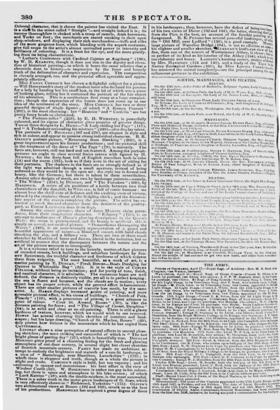NEW SOCIETY OF PAINTERS IN WATER-COLOURS, EXETER HALL.
THIS young Society is fast realizing the promise of its commencement. Almost every individual member has this year taken a step in advance; and the result of their combined efforts is an exhibition highly attrac- tive, and indicative of' the rising excellence and increasing number of the artists who cultivate this delightful branch of painting. We only regret that the pictures are so few, and that the Society should have limited their numbers by the illiberal and impolitic regulation which excludes the works of all but metnbers. Many would gladly exhibit, who, from various reasons, hesitate to identify themselves with a so- ciety. We will venture to say, that an exhibition as numerous and beautiful as the present naight be formed of the works of artists who belong to neither of the two Societies, and who either do not exhibit at all, or are content to send an occasional picture to the Royal Aca- demy or the Suffolk Street Gallery, where it is overlooked altogether, or attracts but a passing glance of recognition. This exclusiveness is the more censurable in this young Society, since it was established ex- pressly to redress the grievances which the monopolizing system of the old Society inflicted on rising talent. We are aware that it was adopted as a measure of self-defence; but even in this light it is i,,excusable, were it likely to be effectual, which it is not. Who would be deterred from joining the old Society by a fine of thirty pounds ? The way to bring new members and to bind them to the Society, is to render the exhibition as attractive as possible by inlisting all the talent that is coining forward : the public encouragement that would follow this course, would soon prove to the exhibiters that it is their interest to continue. The restrictive system was tried in the Society of British Artists, and signally failed : the result will always be that those only who are the least worth keeping will remain. How twig will this narrow-minded and self-seeking spirit prevail in the world of art, divid- ing the interests and fomenting the jealousies of artists, instead of uniting them in one bond of fellowship for the furtherance of the com- mon cause?
It is painful to have occasion to allude to these disagreeable topics in speaking of what would otherwise afford unalloyed gratification ; but a regard for the true interests of the art and its professors obliges us to speak out. Having got rid of our angry feeling, we proceed to the more pleasant part of our task. The principal feature of this exhibition is the pleasing imitation of various appearances of nature in landscape.—the great charm of water- colour painting. There are a few designs of the figure, however, which claim the precedence. Foremost of these in talent and beauty, is a poetic scene from COLLINS'S Ode to Me Passions, by HENRY WARREN, representing the Vale of Tempe, with its maids inspired by Love and Mirth dancing to the minstrelsy (77). Although it does not exhibit such high powers of imagination as are required to do full justice to the subject, it is a graceful exercise of the fancy, in classic taste, and evinces skill in drawing and splendour of colour rarely exhibited in this department of art. This bold and ambitious attempt would be descry- ing of praise, even were it in a less degree successful: it is something to choose such a delightful and difficult subject. In a scene from ac- tual life, Waimea has more completely accomplished his aim : " Street in Damascus" (167), though painted from a sketch by Captain BYAH Mamma, has such a vivid appearance of reality and SO Muth Of Oriental character, that it shows tbe painter has visited the East. It is a vieiftlin the street called " Straight"-and straight indeed it is; its narrow thoroughfare is choked with a troop of camels, Arab horsemen, and Turks on foot ; the merchants are seated smoking in their open shop-windows, and displaying their rich merchandise-stuffs and silks of the most gorgeous hues, which blending with the superb costumes, give full scope to the artist's almost unrivalled power in intensity and brilliancy of colouring. It is a feast for the eye, and the more gratify- ing from its being characteristic. " Luther's Conference with Cardinal Cajetan at Augsburg" (138), by W. H. KEARNEY, though it does not rise to the dignity and eleva- tion of historical painting-to which it bears the same relation that a chronicle does to history-is impressive by the force and homely truth of the delineation of character and expression. The composition is cleverly arranged, too, and the pictorial effect agreeable and appro- priately effective. Miss FANNY CORBAUX has chosen a delightful subject for a picture -Will Honeycomb's story of the modest lover who declared his passion for a lady by handing her his snuff- box, in the lid of which was a piece of looking-glass, telling her it contained the portrait of the fair object of his adoration. This is a meritorious first essay at a large composi- tion ; though the expression of the lovers does not come up to our idea of the sentiment of the story. Miss CORBAUX has two or three graceful designs of single figures ; of which " A Roman Peasant" (282), is the most charming : her "Beatrice" and " Cordelia " are but pretty fancy beads so christened. "The Fortune-teller" (253), by E. H. WEHNERT, is powerfully coloured, and its vigour of character gives promise of greater things. Two or three designs by L. Hiette-" A Lady chiding her Page" ( 1 1 1 ), and "A Trobadour serenading his mistress" (240)-also display talent. The portraits of F. ROCIIARD (187 and 278), are elegant in style and rich in colour, and appear to possess strong individual character. B. R. GREEN'S portrait picture, "Returning from Hawking " (202), is a great improvement upon his former productions ; and the pictorial skill in the treatment of the dress of" The Page" (79), is masterly. The faces are, however, still too hard and set-featured. Among the portrait. pictures we ought to class several Swiss scenes with figures by H. NEWTON; for the ferry.boat full of English travellers both in calm (14) and the storm (195), look as if they were in the act of sitting for their portraits. The shadows in the faces are as strongly defined as if the light was admitted through a small aperture, instead of being softened as they would be in the open air : the style too is formal and heavy, like the German ; but there is talent in them nevertheless. Among other designs of merit, are two by landscape painters-namely, " The Widow" (254), by DUNCAN, and "The Forsaken" (108), by Haanwice. A series of six positions of a battle between two rival chantieleers of the dunghill, by WEiesss, is full of comic humour : we almost bear the shrill note of defiance and the exulting crow of victory, echoed by the straining throat of the fledgling chick ; and the disconso- late aspect of the craven completes the picture. The lutist has ex- tracted as nivel' fun and character from the denizens of the poultry- yard, as EDWIN L A N IES Eflt does from dogs. • Among the scenic pictures, those of JOHN MARTIN claim prece- dence, from their imaginative character. " Kilineny " (124), is an attempt to realize one of lloco's glowing descriptions in the Queen's Wake: the scene is preternatural, and its beauty is artificial : this is simply an unreal, not an ideal picture. " Demosthenes Haranguing the Waves " (149), is an over-wrought representation of a grand and beautiful appearance of nature-a blood-red sunset, with lurid clouds streaking the sky, and a billowy sea. There are two or three small sketches by MARTIN of lanes and downs, literal in the imitation, but so artificial in manner that the discrepancy between the nature and the art of the picture amounts to incongruity. It is a welcome relief to turn to the homely, matter-of-fact pictures of crowded streets, brick buildings, and suburban landscapes by SID- VEY SHEPHERD, the truthful character and freshness of which redeem them from vulgarity. The most beautiful, as a work of art, is a marine painting by E. DUNCAN, "Fresh Breese-Boats Dredging for Oysters in Whitstable Bay" (95). It is in the style of COPLEY FIELDINCI, without being an imitation; and for purity of tone, finish, and nautical character, it is admirable. The numerous boats are well defined, the distance is distinctly visible, yet all is in perfect keeping: the sea is fluent and buoyant, and the clouds are in motion ; every Object has its proper colour, while the general effect is harmonious. There are other smaller pictures of scarcely less merit, by the same artist. L. HAGUE displays increased power of painting, and more *Agreeable pictoral effect, in his views of buildings. "Church of Poix, Picardy" (118), with a procession of priests, is a great advance in
point of colour. ', Cour St. Amend, Rouen" (70), is like the diorama painting for force ; and "The Village of Casset, Dauphine" (64), is as solid and cleat as an oil.painting. There is still a glassy bardness of texture, however, which we would wish to see removed. Howse has several charming little sketches of interiors and land- scapes; but his large drawing, "Church of St. Maclou, Rouen" (20), Only proves how vicious is the mannerism which he has copied from
CATTERMOLE.
LINDSAY shows a nice perception of natural effects in several pleas- ing sketches; the most striking and successful of which is " The last bnght gleam of parting day" (21), which is beautifully true. DOUGLAS MORISON gives proof of a charming feeling for the fresh and glowing atmosphere of out-door scenery, in several slight but clever sketches of Scottish mountain-scenery. FAIIEY has made an ambitious at- tempt to embody the brightness and warmth of a sun-lit landscape, in a view of " Barncleugh, near Hamilton, Lanarkshire" (173) ; in whiSh there is elegance and truth, though as a whole the picture is slight and crude. CAMPION'S style is bold, but too vapoury ; and his tcolouring is opaque and monotonous: his best effort is the view of Windsor Castle (62). W. ROBERTSON is rather too gay in his colour- ing, but there is space and atmosphere in his lake scenes; of which " Loeb Katnne " (18), with the double rainbow, is the most successful. There is a sober truth in the moist green landscapes of G. SIMS, which is very effectively shown in " Richmond, Yorkshire" (175). OLIVER'S two mehitectural views at Rouen (182 and 193), struck us as the best of his productions. HAEDRICKE has Requited a great degree of force in his landscapes; they, however, have the defect of being two Leah of his two views of Dover (132 and 144), the latter showing theca,- S from the Pier, is the best, on account of the forcible painting sr foreground. R. K. PERSON has several powerful landscapes; of ,yt
the " Old Mill, near Lydford " (150), is a good example. Alse" ,
large picture of Waterloo Bridge_(184), is not so effective as sons; his slighter and smaller sketches. WEARNAN'S bird's.eye view of Is;, don, from one of the towers of Westminster Abbey, is clever; but so perfect of its kind as his interior of the Abbey (154), which issi; too elaborate end heavy. LAPORTE'S hunting scenes, studies of flow by Mrs. HAttmsoN (134 and 140), and a study of the Tiger init. Surrey Zoological Gardens (168), by Miss Louisa CORBUX....clo has mastered the animal completely-are the principal among the es cellaneous piettnes in the exhibition.



























 Previous page
Previous page